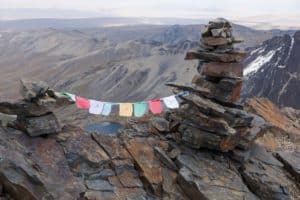A hermit lived alone in the mountains. One day a herdsman passed by his cave. Intrigued, he called out to the hermit: “What are you doing alone in the middle of nowhere?”
The hermit replied, “I am meditating”.
“What are you meditating on?” asked the herdsman.
“On patience,” said the hermit.
There was a moment of silence. The herdsman turned to go, looked back and shouted, “By the way, go to hell!”
“What? You go to hell!” came the reply from cave.
The herdsman roared with laughter and reminded the hermit that he was practicing patience!
To practice patience, in a situation which would typically lead to anger, how can we remain calm? All of us confront situations dealing with our children, family members or coworkers, that test the limits of our patience. It is clear from the story that patience is something that cannot be cultivated in isolation, it has to be practiced in the context of our interactions with others.
I had a chance to practice this week, as I woke up to a bit of chaos in our building – on my day off! No electricity and the thermostat read 64 degrees, no small matter for someone from the tropics, where there are two seasons: hot and monsoon. I could hear commotion and water falling in the corridor. Puzzled, I stepped out and found water pouring down from the ceiling 50 ft down the hallway and the corridor was flooding rapidly.
Once the initial shock settled in, I came back in, took a few deep breaths and reassured myself that in America they will fix it soon. Then I was able to get on to practical matters such as collecting water before it was shut-off (like India, where there are limited hours when water is available!). I realised an opportunity for me to reflect on anger and a teaching moment after my 10 year-old reacted by blaming bad management. When asked why he was angry with them, he replied, “It is better than blaming myself”.
In “Healing Anger: The Power of Patience”, the Dalai Lama writes: To cultivate our potential for development of compassion and love, inherent parts of us, it is crucial to counteract their opposing forces by means of patience or tolerance. Only through patience can one overcome the obstacles to compassion. If we can realize that tolerating hardship can have long-term beneficial consequences, we are more likely to be able to tolerate everyday hardships. If we kindle tolerance and patience then we will be able to foster calmness and presence of mind. Even in a very tense environment – frantic and stressful – our calmness and presence of mind will not be disturbed.
Visualization meditation: Imagine a scenario where someone close to you loses their temper. This person is intensely angry, has lost their composure, and even harms themselves and breaks things. Then reflect upon the effects of this. It helps to visualise this happening to someone else because it is easier another’s faults, as opposed to your own. Visualise the transformation happening to them. This person, with whom you are close, whose very image gave you pleasure, has turned into anger personified. This is an analytic meditation, so stay with the image a while.
Now think of your own experience. Then resolve, “I shall never let myself be this angry. Because if I do, I will suffer – lose my peace of mind, composure and assume face of anger.” Make the decision and remain in an absorptive meditation on the conclusion.
Whatever befalls me
I shall not disturb my mental joy;
For having been made unhappy, I shall not accomplish what I wish
And my virtues will decline.
8th c Indian sage Shantideva (Guide to the Bodhisattva’s way of life)

